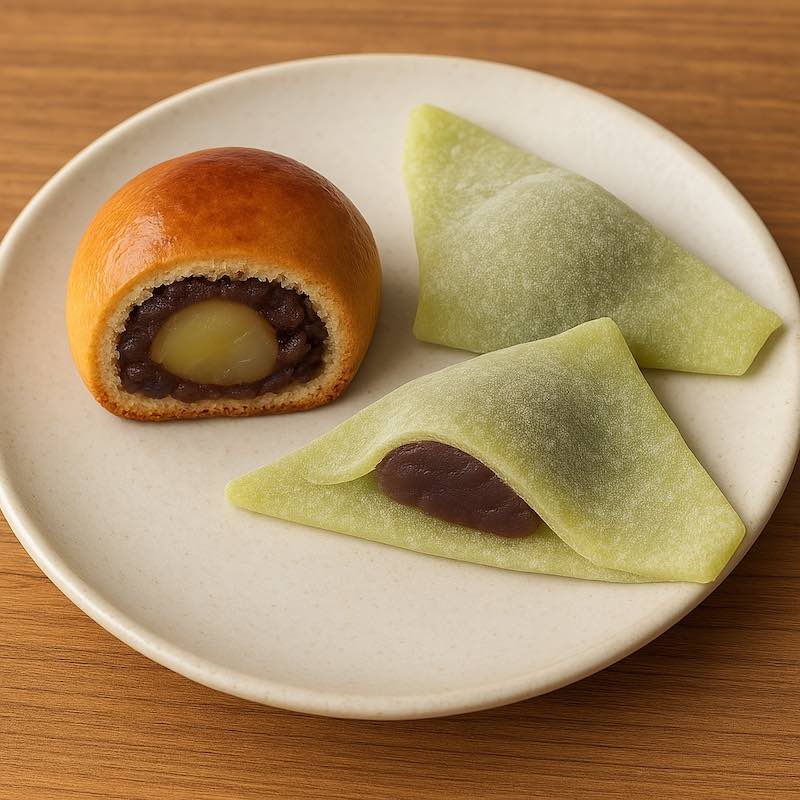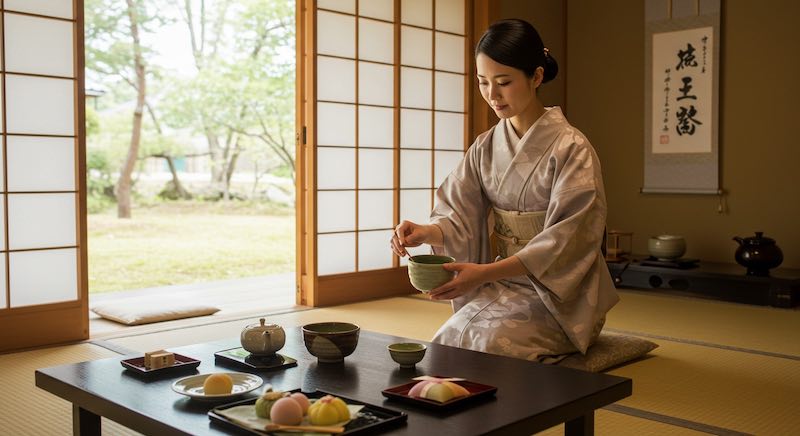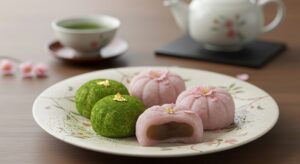A Long History of Japanese sweets: The Origins and Evolution of Wagashi
Wagashi, traditional Japanese sweets, are more than just confectionery; they are an embodiment of Japanese culture, history, and aesthetic sensibilities.
The delicate designs that reflect the changing seasons, the deep connection with the refined culture of the tea ceremony, and above all, the passion of artisans who pursue both flavor and beauty give Wagashi a unique spirituality.
This article delves into the origins and evolution of Wagashi nurtured over a long history, its crucial role in the tea ceremony, the dedication of its craftspeople, and the Japanese aesthetic woven into each piece.
Table of Contents
Ancient Roots: From Nuts and Mochi
The origins of Wagashi can be traced back to ancient times when humans began using nature’s bounty as food.
Nuts ground into powder and formed into balls became the prototype for dumplings, and mochi (pounded glutinous rice) is considered one of Japan’s oldest processed foods.
By the Yayoi period (around 300 BCE to 300 CE), dumplings made from grains and rice flour were common.
These simple foods held the seeds of what would later become Wagashi.
Elegance in the Nara and Heian Periods: Tangashi and Court Culture
During the Nara period (710-794 CE), Tangashi (Chinese-style confectionery) were introduced to Japan by envoys to the Tang Dynasty in China.
These were mainly made from kneaded rice, wheat, soybean, and azuki bean flour, flavored with sweet miso, and deep-fried.
They were highly valued as ceremonial foods.
While sugar was introduced to Japan around 750 CE, it wasn’t widely used in Wagashi until the Edo period (1603-1868 CE). In the Heian period (794-1185 CE), the first beautifully designed confections appeared.
The Tale of Genji, a classic work of Japanese literature, mentions Tsubaki-mochi (camellia mochi) and Aosashi.
Initially, Tsubaki-mochi was unusual among Tangashi for not being deep-fried, but it was later adapted to Japanese tastes.
It originally consisted of glutinous rice flour sweetened with amazura (ivy sap), wrapped in camellia leaves. Later, sugar was used, and it was filled with sweet bean paste (anko).
Confections during this era were primarily offerings to the aristocracy.
Zen in the Kamakura and Muromachi Periods: Japanese sweets incorporated into the tea ceremony
In the Kamakura period (1185-1333 CE), Japanese Zen Buddhist monks who had studied in Song Dynasty China brought back the culture of tea, and the custom of eating sweets with tea began.
They also introduced tenjin, light meals, some of which were the prototypes for later manju (steamed buns) and yokan (sweet bean jelly).
By the Muromachi period (1336-1573 CE), manju had evolved from savory food to sweet confections filled with bean paste.
Yokan, initially a soup using lamb meat, transformed into a sweet made with azuki beans and wheat flour in Japan, where meat consumption was not common.
Kissako, a 14th-century text, describes the practice of serving matcha (powdered green tea) with sweets, indicating the beginning of the close relationship between tea and confectionery.
Flourishing in the Edo Period: Diversification and Spread to the Common People
The Edo period (1603-1868 CE) was a time of remarkable development for Wagashi, laying the foundation for the forms we see today.
A long period of peace, economic growth, and an increase in domestic sugar production made sugar widely available to the general public.
Wasanbon, a fine-grained sugar produced in Sanuki Province (now Kagawa Prefecture), was particularly prized as a high-quality ingredient.
Classical literature and the elegance of the seasons began to be used in the names of Wagashi.
During the Genroku era (1688-1704 CE), when the vibrant Genroku culture flourished, beautiful Wagashi with designs inspired by classical literature and the four seasons, influenced by the Rinpa school of art, were created.
Delicate namagashi (fresh confections) like nerikiri, which are shaped to resemble seasonal flowers and animals, originated in Kyoto and spread throughout the country.
Yatsuhashi, a famous Kyoto specialty, also emerged during this period.
Additionally, the culture of dagashi (penny candy) blossomed among the common people.
Innovation After the Meiji Restoration: Western Influence and Modern Times
With the Meiji Restoration (1868-1912 CE), trade with the West increased, leading to the introduction of modern equipment such as ovens, and the appearance of baked Wagashi like kuri-manju (chestnut buns) and kasutera-manju (sponge cake buns).
The term “Wagashi” itself was coined in the late 1800s to distinguish traditional Japanese confectionery from Western sweets (yogashi).
However, it wasn’t until after World War II that the term became widely used.
In the 21st century, Wagashi continues to evolve, incorporating Western ingredients and innovative designs while preserving tradition.
Nama-yatsuhashi, a raw version of yatsuhashi that emerged in 1960, became a popular souvenir from Kyoto.
In 2014, Mizu Shingen Mochi (water cake), a creation by a Wagashi shop in Yamanashi Prefecture, gained international attention.

Tea Ceremony and Japanese sweets: Harmony Enhancing Spirituality
The Role and Importance of Japanese sweets in the Tea Ceremony
In the Japanese tea ceremony (chanoyu or sado), Wagashi is not merely an accompaniment but a crucial element for enhancing spirituality.
At a tea gathering, Wagashi is served before the bitter matcha to soften its taste and allow for a deeper appreciation of its flavor.
Wagashi also expresses the season and conveys the host’s hospitality. Harmony with the atmosphere of the tearoom and the tea utensils is also considered, pursuing an overall aesthetic.
- Click here to learn more about matcha, which goes perfectly with Japanese sweets: How About Some Matcha? Japan’s Charming Green Gift
Types and Meanings of Wagashi Served at Tea Gatherings
Wagashi served at tea gatherings are typically small, bite-sized pieces, broadly categorized by moisture content into omogashi (main sweets) and higashi (dry sweets). Omogashi, which have a higher moisture content and include fresh confections like nerikiri, are typically served with koicha (thick tea), while higashi, which have lower moisture content and include pressed sugar candies like rakugan, are generally served with usucha (thin tea).
Besides nerikiri, other omogashi include mochi, manju, and yokan. Higashi include rakugan, konpeito (sugar candy), and senbei (rice crackers).
When enjoying Wagashi at a tea ceremony, it is customary to lightly hold the sweet dish, use a kuromoji (black toothpick) to take a piece, place it on kaishi (paper napkins), admire it, and then eat it in two or three bites.
Responding to the Seasons: Tea Sweets Telling the Story of Time
The shapes, colors, and ingredients of Wagashi served in the tea ceremony are carefully chosen to delicately express the changing seasons.
In spring, you might find sakura-mochi (cherry blossom mochi), uguisu-mochi (bush warbler mochi), and hanami-dango (cherry blossom viewing dumplings).
Summer brings mizu-yokan (water yokan) and kuzu-kiri (arrowroot noodles). Autumn features kuri-kinton (mashed sweet chestnuts) and tsukimi-dango (moon viewing dumplings).
Winter offers kanoko (fawn-spotted beans) and kinako-mochi (roasted soybean flour mochi), as well as hanabira-mochi (flower petal mochi).
Each season’s Wagashi uses unique designs and ingredients to enhance the tea gathering.

The Soul of the Japanese sweets artisan: Passion Dedicated to Flavor and Beauty
Carefully Selected Ingredients: Utilizing the Blessings of Nature
The main ingredients of Wagashi are primarily plant-based, including rice, beans (especially azuki beans), sugar, and agar-agar. Valuing seasonal ingredients is also a key characteristic of Wagashi. An (sweet bean paste) is particularly considered the “lifeblood of Wagashi,” and its flavor is greatly influenced by the type of beans and the artisan’s skill.
Traditional Techniques: Beauty Born from Delicate Handwork
Wagashi making is mainly done by hand by skilled artisans who undergo years of training.
Various techniques are employed, including boiling, kneading, steaming, shaping with molds, and forming by hand, all requiring high precision.
Simple yet well-used tools are wielded by the artisan’s hands to create artistic works.
Spirituality Embodied in Design: Deciphering the Artisan’s Thoughts
The delicate designs of Wagashi express seasonal features, natural landscapes, and traditional events.
Each piece is a small work of art, imbued with the artisan’s skilled techniques and rich sensibility.
They are sometimes given names inspired by haiku poems or classical literature, and understanding this background allows for a deeper appreciation of the world of Wagashi.
Japanese Aesthetics and Wagashi: Resonance with Nature
Harmony with Nature: Nature’s View Residing in Shape, Color, and Material
The spirit of wabi-sabi, a traditional Japanese aesthetic, resides in Wagashi.
This concept, which values simple, rustic beauty and an appreciation for things that change with the passage of time, is reflected in the shapes, colors, and materials of Wagashi.
Natural elements and the artisan’s delicate handwork harmonize beautifully, expressing the changing seasons and the beauty of nature.
Expression of Seasonality: Depicting the Fleeting Beauty
One of the most prominent features of Wagashi is its rich expression of the four seasons.
Through color, shape, and ingredients, it delicately portrays the fleeting beauty of the changing seasons.
The Spirit of Wabi-Sabi: Deep Flavor in Simplicity
While having a visually appealing appearance, Wagashi embodies the spirit of wabi-sabi, seeking deep flavor in simplicity. It avoids excessive ornamentation, finding profound beauty in the texture of natural ingredients and subtle sweetness.
Exploring Representative Wagashi
Nerikiri

- History:
Nerikiri originated in Kyoto during the early Edo period (around the 1600s) and later spread to Edo (Tokyo) and throughout the country.
Due to the high cost of sugar at the time, it was mainly a luxury confectionery served at tea ceremonies and special occasions. - Characteristics:
It’s a type of namagashi (fresh confection) with a moisture content of over 30%, characterized by its beautiful appearance and delicate flavor. - Production Method:
Made by adding gyuhi (a type of mochi), shiratamako (glutinous rice flour), and sometimes Japanese yam to white bean paste (shiroan).
This creates a smooth, elegant sweetness and a slightly chewy texture. - Inherent Meaning:
Its delicate designs, often depicting seasonal flowers, animals, and landscapes, showcase the artisan’s skilled techniques and rich creativity.
Natural materials and food coloring are used for coloring.
Some nerikiri have a filling of sweet bean paste inside.
In the tea ceremony, it plays a particularly important role due to its emphasis on seasonality and its delicate beauty.
If you want to buy Nerikiri, go to the Japanese sweets store that opened in 1803.: Kameya-Yoshinaga
Yokan
-300x200.jpeg)
- History:
Yokan originated as a soup using lamb meat in China.
It was introduced to Japan by Zen Buddhist monks from the Kamakura to the Muromachi periods.
Since monks were prohibited from eating meat, they began using azuki beans and kudzu flour instead of lamb, creating the prototype for today’s yokan.
In the Edo period, the use of agar-agar became common, leading to the mainstream neri-yokan (sweetened bean jelly). - Types:
The main types include neri-yokan, mizu-yokan (water yokan), and mushi-yokan (steamed yokan). - Production Method:
Neri-yokan is made by simmering azuki bean paste, sugar, and agar-agar and pouring it into a mold, resulting in a firm, smooth texture.
Mizu-yokan has a higher water content than neri-yokan, giving it a smoother texture and making it popular in summer.
Mushi-yokan is made by steaming a mixture of wheat flour or kudzu flour without using agar-agar, resulting in a chewy texture. - Charm of Flavor:
There are also various types of yokan throughout Japan that use different ingredients such as chestnuts, sweet potatoes, and fruits.
The most famous yokan shop in Japan: TORAYA
Monaka

- History: Monaka is said to have appeared in the Edo period.
It is a Wagashi made of thin, fragrant wafers made from glutinous rice, filled with sweet bean paste.
Initially, it was a simple confection sprinkled with sugar, but it is said to have evolved into its current form with a filling of bean paste in the Meiji period. - Distinctive Designs:
The wafers are made by steaming and drying glutinous rice, grinding it into flour, kneading it with water, and baking it in a mold at high temperatures. - Production Method:
This creates a crisp, light texture that contrasts with the filling. - Diverse Expressions:
The filling is traditionally sweet azuki bean paste (anko), but there are various variations including matcha, chestnut, and even ice cream.
The shape of the wafers also comes in a wide variety of designs besides squares and triangles, such as flowers like chrysanthemums and cherry blossoms, animals, and local landmarks. Auspicious motifs are also commonly used.
My top pick for Kyoto Monaka is here: Taneka-Shoten
To Deepen Your Understanding of the Spirituality of Wagashi
To gain a deeper understanding of the spirituality of Wagashi, it is beneficial to consult books, expert opinions, and museum explanations.
Reading books on the history and culture of Wagashi will allow you to learn about the underlying philosophies and aesthetic sensibilities.
Furthermore, reading interviews and works by Wagashi artisans can provide insight into their passion, techniques, and philosophy towards Wagashi.
Museums and galleries offer a more concrete understanding of the artistry and cultural significance of Wagashi through exhibitions.
Organizations such as the Japan Wagashi Association also contribute to the preservation and promotion of Wagashi culture.
The Allure of Wagashi Experienced Through the Five Senses
Wagashi is an existence that embodies its long history, deep connection with the tea ceremony, the flavor and beauty infused with the soul of the artisan, and Japanese aesthetics.
Each representative Wagashi, such as nerikiri, yokan, and monaka, encapsulates history, culture, and the thoughts of the artisan.
Wagashi is not just for tasting; by appreciating its beautiful designs, feeling the changing seasons, and contemplating the artisan’s skills, it provides an opportunity to deeply understand Japanese culture and spirituality through all five senses.
We encourage you to try various Wagashi and experience their profound charm.
[taxopress_relatedposts id=”1″]


Leave a Reply